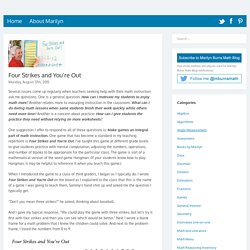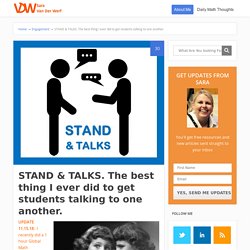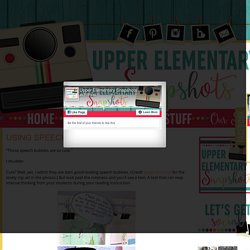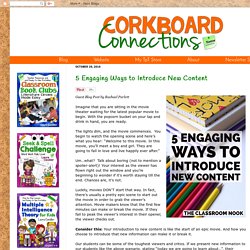

You need to MOVE in your math class EVERYDAY! - Sara VanDerWerf. Hello blog friends!

This blog post is the tip of the iceberg in a series of blog posts on incorporating movement into the math classroom. In the next several months I will be writing about 20+ movement activities – Many will include video. You will also get to know my amazing friend Allison Rubin who inspired me to move in my own classroom and also connect to the work of Chris Luzniak who I am presenting with at several national math conferences in 2019-2020. I believe EVERY single K-12+ classroom should have their students moving every single class period for at least 2 minutes every 25 minutes.
Four Strikes and You're Out. Several issues come up regularly when teachers seeking help with their math instruction ask me questions.

One is a general question: How can I motivate my students to enjoy math more? Another relates more to managing instruction in the classroom: What can I do during math lessons when some students finish their work quickly while others need more time? Another is a concern about practice: How can I give students the practice they need without relying on more worksheets? One suggestion I offer to respond to all of these questions is: Make games an integral part of math instruction. One game that has become a standard in my teaching repertoire is Four Strikes and You’re Out. When I introduced the game to a class of third graders, I began as I typically do. “Don’t you mean three strikes?” And I gave my typical response, “We could play the game with three strikes, but let’s try it first with four strikes and then you can see which would be better.” STAND & TALKS. The best thing I ever did to get students talking to one another. - Sara VanDerWerf. UPDATE 11.15.18: I recently did a 1 hour Global Math Department Presentation on ‘Stand & Talks’.

You can view a recording of that presentation HERE. In the presentation I share a link to a google folder of additional resources I’ve developed since writing this blog post. This post is my #1 tip for math teachers in 2017-18. It has been the secret to increasing the number of students who talk out loud about math each day in class to nearly 100% – everyday. The best news is anyone can do this. Becoming the Math Teacher You Wish You'd Had. American Indians in Children's Literature (AICL) Celebrate Science. Dr. Nicki's Guided Math Blog. Using Speech Bubbles in Reading. "Those speech bubbles are so cute.

" I shudder. Cute? Well, yes, I admit they are darn good-looking speech bubbles. (Credit Sarah Pecorino for the lovely clip art in the photos.) But look past the cuteness and you'll see a tool. Here are five ways to use speech bubbles when reading literature: Try using speech bubbles as a vehicle for your students to interact with the characters in a text. Doing so can entrench a student into the story. Sticky notes work perfectly to do this while reading. Pull two characters out of their story to create a conversation between them, similar to an exchange of texts to each other. As a compelling spinoff, take a main character out of two separate books to try a character conversation. Give words to a character or animal who doesn't otherwise speak. Use one chapter of a book (or a whole picture book) to have students decide the most important quotation uttered by one of the characters.
It reminds me of the "Say WHAT?!? " Making Math More Fun Math Board Games. Start Here - Read-Aloud Revival with Sarah Mackenzie. Missing Tooth Grins. Home - Robert Kaplinsky. Runde's Room. Teaching in Room 6. A Challenge to All Educators – Steve Wyborney's Blog: I'm on a Learning Mission. Donalyn Miller.
5 Engaging Ways to Introduce New Content. Guest Blog Post by Rachael Parlett Imagine that you are sitting in the movie theater waiting for the latest popular movie to begin.

With the popcorn bucket on your lap and drink in hand, you are ready. The lights dim, and the movie commences. You begin to watch the opening scene and here’s what you hear: “Welcome to this movie. In this movie, you’ll meet a boy and girl. Um…what? Luckily, movies DON’T start that way. Consider this: Your introduction to new content is like the start of an epic movie. Our students can be some of the toughest viewers and critics. While teachers aren’t trained movie producers, we can still use some tricks and strategies to grab our students’ attention and get them excited about the new information they are about to learn. Course: Grade 4 General Resources.
Teaching With a Mountain View. Cult of Pedagogy. TWO WRITING TEACHERS. The Power of Language by Stacey Shubitz Clear, specific feedback helps children view themselves in a positive light in the learning environment and in life.

Choice Words Giveaway Recipient Many thanks to Stenhouse Publishers for donating a copy of Choice Words to one of the people who read and commented on the post that included an interview with Peter H. Johnston. A Few Questions for Peter H. I’ve learned the importance of communicating clearly with students through the Responsive Classroom training I’ve had and books I’ve read about teacher-talk. Praising Kids. I’ve been doing Pilates since August 2008. Peter Johnston + Agency by Ruth Ayres These words of Peter Johnston’s from his book Choice Words (2004) have been tumbling around in my mind this weekend.
The Language We Use When We Teach I attended a workshop with Peter H. MAKING KIDS FEEL BIG, NOT small. I had the pleasure of hearing Linda Christensen deliver the keynote address at today’s RIWP Spring 2008 Conference.